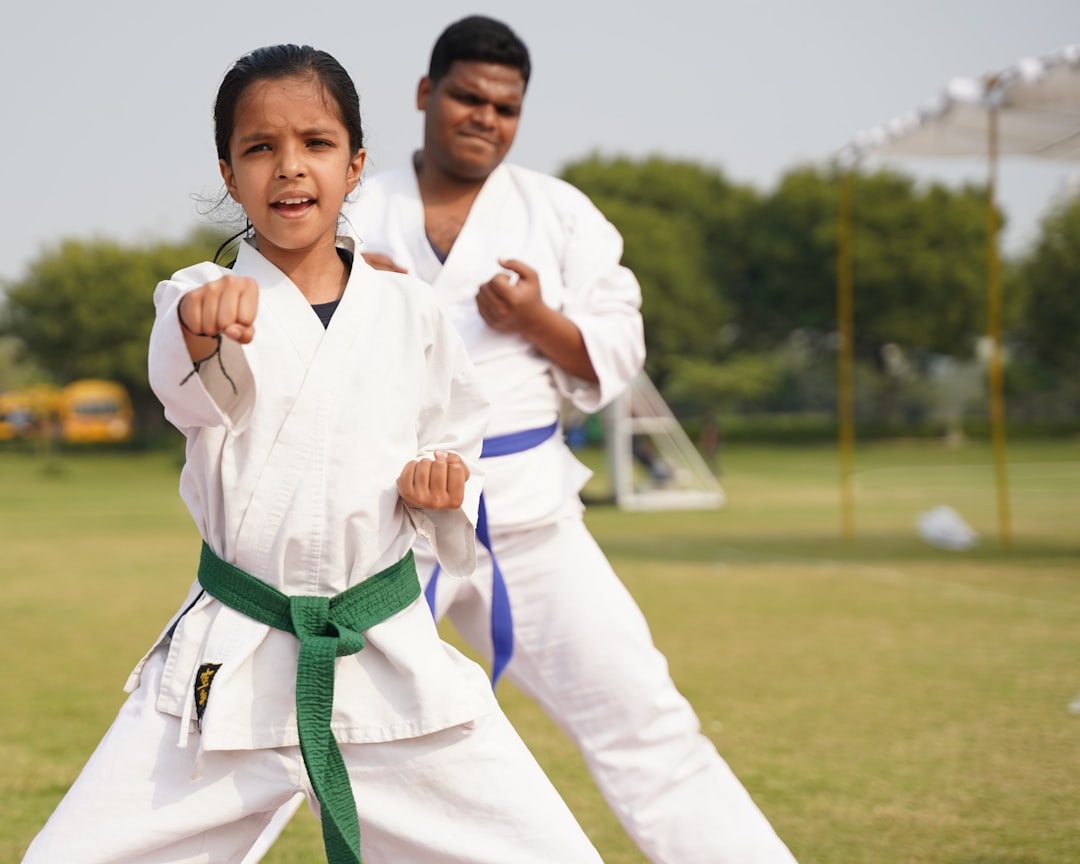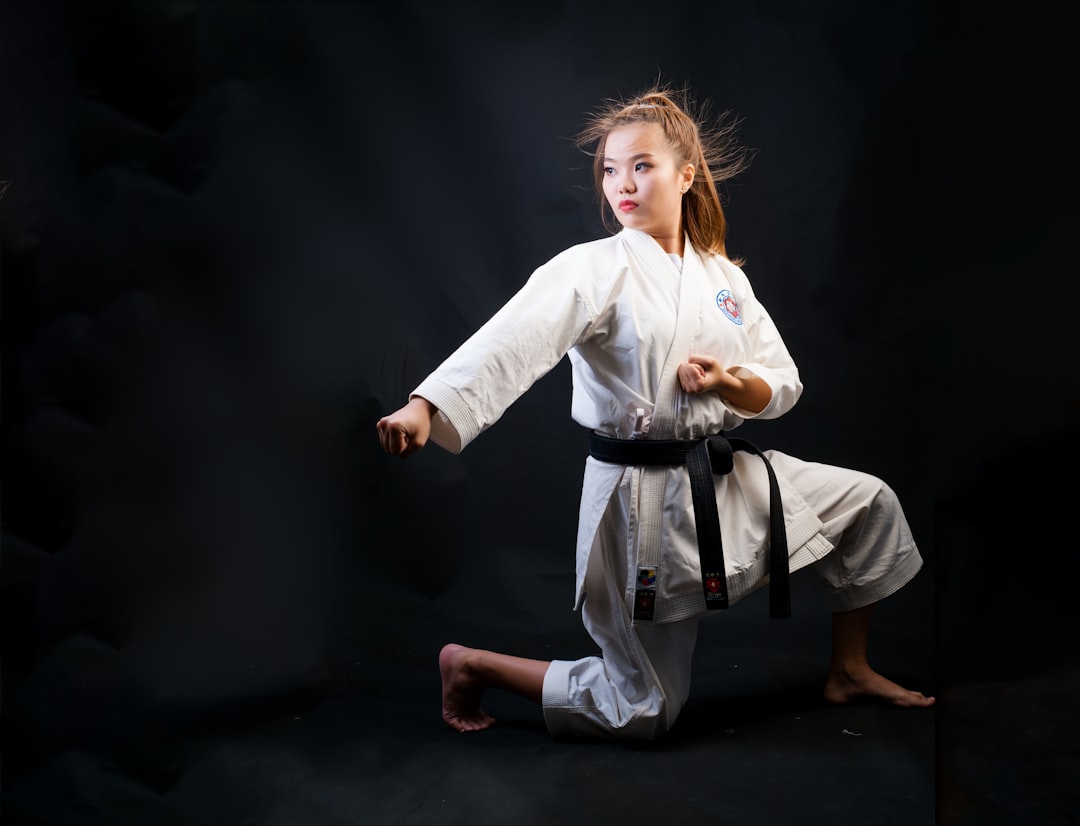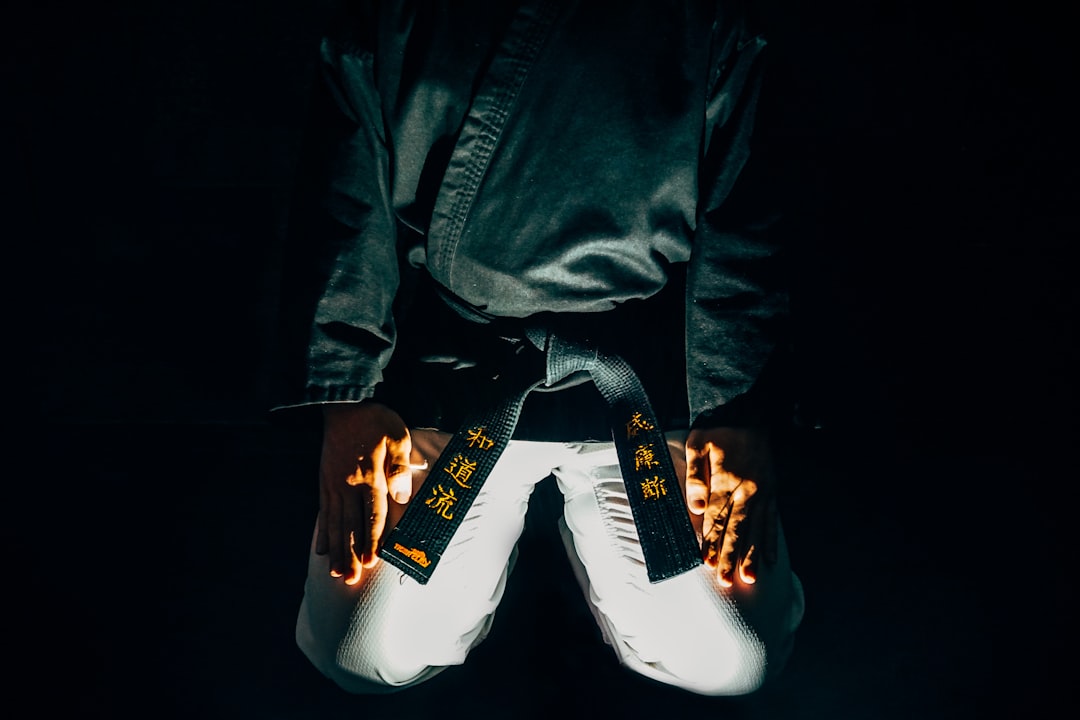To effectively and safely train karate at home, it's important to set up a clear, unobstructed area with ample space for all types of movements. Investing in high-quality martial arts mats is crucial for impact absorption during kicks and falls, prioritizing joint protection and injury prevention. A heavy bag—either hanging or freestanding—filled with sand or synthetic fiber is an essential tool for practicing striking techniques without a partner. Protective gear like well-designed gloves and shin guards should be included to ensure safety during intense training sessions. Your home dojo should have smooth, non-slip flooring, adequate lighting, and proper ventilation to maintain focus and energy levels. Personal touches that resonate with your karate journey can help foster dedication and respect for the art. Additionally, incorporating specific training tools like wall-mounted bags, adjustable dummies, balance boards, yoga mats, and various types of punching bags will enhance your practice by targeting different skills and aspects of martiate arts training, ensuring a comprehensive home karate experience that rivals traditional dojo settings. Remember to include safety gear like a mouthguard, groin guard, and hand protectors for additional protection. Warm-ups are also vital to prevent muscle or joint strain and to prepare your body for the demands of karate practice at home. By integrating these elements into your routine, you can create a safe, effective, and rewarding home karate training environment.
Embarking on a karate journey from the comfort of your own home requires careful planning to ensure you have the necessary equipment and space for effective practice. This article serves as a guide, detailing what to bring for training karate at home. From setting up a conducive environment to mastering moves with core equipment, we’ll cover essential gear, protective measures, and supplementary tools to enhance your training experience. Whether you’re a beginner or an experienced practitioner looking to train karate home, this comprehensive overview will help you optimize your space for optimal practice.
- Essential Gear for Training Karate at Home: A Comprehensive Guide
- The Ideal Space: Setting Up Your Home Karate Dojo
- Core Equipment: What You Need to Master Karate Moves
- Protective Gear and Safety Precautions for Home Karate Practice
- Supplementary Tools: Enhancing Your Training with Aids and Accessories
Essential Gear for Training Karate at Home: A Comprehensive Guide

When training karate at home, having the right gear is crucial to ensure safety and effectiveness. What are the essential items necessary for a comprehensive home karate training setup? To begin with, a suitable training area is paramount; this means clearing a space free of potential hazards and ensuring there’s enough room to execute movements safely. A well-padded mat is essential for protecting your joints and reducing the risk of injury when practicing techniques like kicks and falls. Are you looking for the perfect surface to practice on? Consider investing in high-quality mats designed specifically for martial arts training, which provide the necessary cushioning and support.
In addition to a safe training area, appropriate equipment is also necessary. A heavy bag is an excellent investment for practicing strikes and kicks, allowing you to refine your technique and build strength without the need for a partner. Are you considering what type of punching bag to get? Opt for a free-standing or hanging bag that’s filled with sand or synthetic fiber, as these are designed to withstand powerful blows and provide a realistic training experience. Additionally, protective gear such as gloves and shin guards will safeguard your hands and legs from injuries during practice. Do you need gear that can endure the intensity of karate training? Gloves that offer both protection and dexterity, and shin guards that are comfortable yet sturdy, are highly recommended for home training sessions.
The Ideal Space: Setting Up Your Home Karate Dojo

When training karate at home, having a dedicated space—your own home dojo—can significantly enhance your practice. To set up an ideal space for training karate at home, consider the dimensions and layout of the area you have available. Is the space large enough to allow for full range of motion without obstruction? Ensure that there is ample room to execute kicks, blocks, and strikes with ease. Next, assess the flooring; a smooth, non-slip surface like vinyl or rubber mats is ideal as it cushions your joints during practice. Are there any potential hazards like sharp objects or furniture that could cause injury? Remove or secure these to prevent accidents. Proper ventilation and lighting are also crucial for maintaining focus and energy levels throughout your training sessions. Can you position your dojo near a window or source of natural light to enhance the ambiance and reduce eyestrain? Lastly, consider the aesthetic and inspirational aspects of your home dojo. Personal touches like a small shrine or display of your karate gear can foster a sense of dedication and respect for the martial art. Are you incorporating elements that resonate with you personally and reinforce your commitment to training karate at home? By thoughtfully arranging your home dojo, you create an environment conducive to discipline, focus, and continuous improvement in your karate practice.
Core Equipment: What You Need to Master Karate Moves

When training karate at home, having the right equipment is crucial for mastering the moves and techniques essential to the discipline. The first core piece of equipment every karateka should consider for their home training setup is a quality punching bag or mitts. This allows you to practice strikes with precision and control, ensuring you can develop both power and technique without the need for a partner. Additionally, a stable and sturdy floor mat is necessary to protect your joints and bones during practice, particularly when performing kicks and high-impact movements. Do the mitts enhance your strike accuracy? Absolutely, as they provide a realistic target that mimics an opponent’s body parts. Are floor mats essential for home training? They are, as they offer both cushioning and traction to prevent slipping during vigorous exercise. Combined with a focused mindset and dedication to practice, these items will significantly contribute to your karate training regimen at home.
Protective Gear and Safety Precautions for Home Karate Practice

When training karate at home, ensuring your safety is paramount to prevent injuries and make the most of your practice sessions. A fundamental piece of protective gear for home karate practice includes a well-fitted mouthguard to safeguard your teeth and gums during practice kicks and punches. Are you looking for additional protection? Consider investing in a groin guard for men, as well as hand protectors or padded gloves designed specifically for martial arts. These will help cushion your hands from the impact of strikes on hard surfaces or walls, which are common when training at home without a partner. Additionally, ensure that you have a sufficiently padded karate gi to absorb some of the force from techniques like kicks and blocks. When practicing kata or forms, mirrors can be invaluable for checking your stances and form; however, position them safely to avoid injury from accidental strikes. Lastly, always warm up before starting your training to prepare your muscles and joints for the rigorous movements involved in karate, reducing the risk of strain or injury. What kind of flooring do you have at home? If it’s hard, consider using a protective mat to lessen the shock on your knees, hips, and ankles during exercises like sparring or practicing katas. Remember to keep your training area clear of obstacles to avoid tripping or falling. By taking these safety precautions and utilizing appropriate protective gear, you can train karate at home effectively and safely.
Supplementary Tools: Enhancing Your Training with Aids and Accessories

When training karate at home, incorporating supplementary tools can significantly enhance your practice and aid in achieving a more comprehensive workout. For instance, do you need equipment that targets specific aspects of your training? Consider a wall-mounted bag for practicing strikes with precision or an adjustable dummy to refine your techniques. These aids can simulate the resistance and responses of a human opponent, allowing for a more immersive experience. Additionally, balance training tools like wobble boards or balance cushions are excellent for developing core stability, which is crucial for maintaining proper form during various karate kata and movements. Are you looking to improve your flexibility and balance? Yoga mats provide a safe, non-slip surface for floor exercises, while balance boards challenge your equilibrium and coordination, both of which are key components in martial arts training. By integrating these supplementary tools into your home training regimen, you can elevate your karate skills and ensure a well-rounded practice session. How can you enhance your focus and rhythm? Punching bags come in various types, from free-standing models to traditional hanging ones, and they are excellent for timing, power development, and improving the fluidity of your strikes. To further refine your techniques, electronic scoring systems can offer instant feedback on your accuracy and consistency. With the right combination of supplementary tools and consistent practice, training karate at home can be as effective as in a dojo.
In conclusion, establishing a conducive environment and equipping oneself appropriately are key components for effectively training karate at home. Whether you’re an experienced practitioner or just beginning your martial arts journey, the right gear and a dedicated space can significantly enhance your practice. From mastering basic moves to advancing your skills, the core equipment listed in this guide ensures safety while allowing for precise technique development. Don’t overlook the importance of protective gear to safeguard against injuries during your home training sessions. Additionally, the supplementary tools suggested can provide valuable support, further refining your karate practice. Remember, with the right setup and resources, training karate at home is a feasible and rewarding endeavor.
